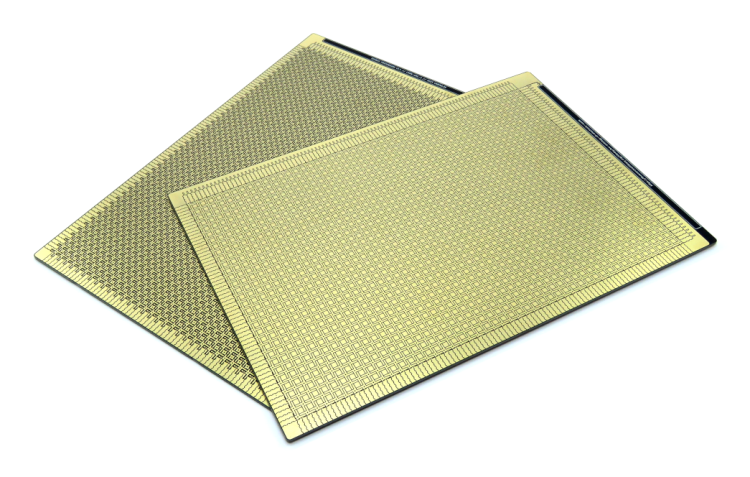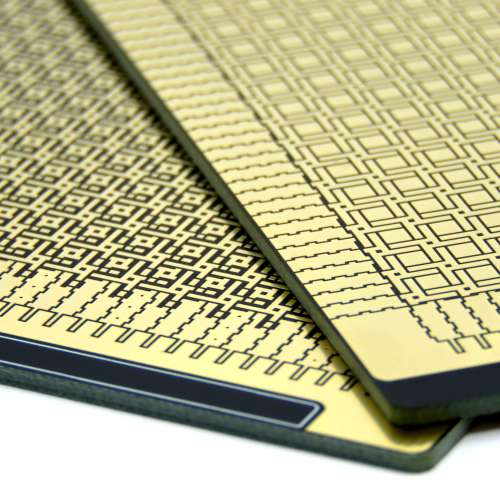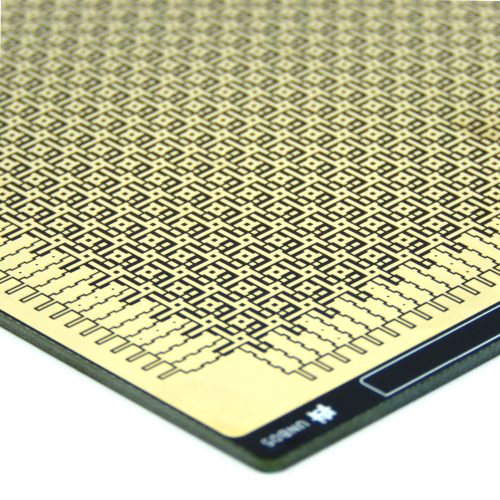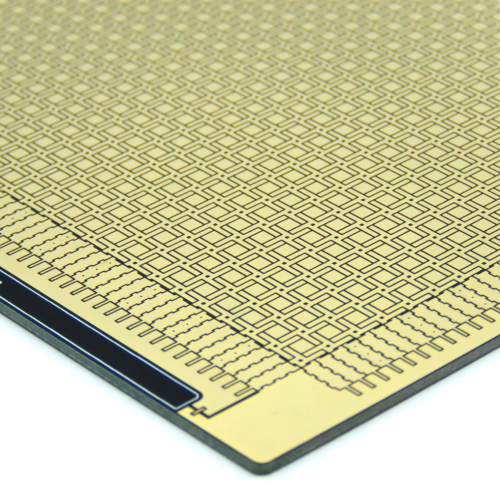DEDBUG Protoboard: Difference between revisions
Unbinawiki (talk | contribs) (Added photos and diagrams.) |
Unbinawiki (talk | contribs) (Added a table with a description of the DEDBUG Protoboard [Front]) |
||
| Line 16: | Line 16: | ||
|} | |} | ||
{| class="wikitable" | |||
|+ | |||
!Color | |||
!Function | |||
!Description | |||
|- | |||
|[[File:Blue table icon.png|frameless|50x50px]] | |||
|BUS | |||
|A bus on the right and bottom edge of the Protoboard. On the top right edge of the Protoboard it is possible to solder a wire or attach a [[wikipedia:Crocodile_clip|crocodile clip]] to create either a VCC or GND Bus. | |||
|- | |||
|[[File:Orange table icon.png|frameless|50x50px]] | |||
|Edge Pads | |||
|The edge pads can be bridged with the Bus, bridged to adjacent edge pads and bridged with the prototyping area. It is possible to bridge with just solder, or an 0402-sized zero-ohm resistor. | |||
|- | |||
|[[File:Yellow table icon.png|frameless|50x50px]] | |||
|Edge Pads [Vias] | |||
|These edge pads connect to the edge pads on the other side using vias. If one side has a VCC Bus and the other the GND bus, it is possible to complete a circuit by bridging an edge pad with vias on the relevant side so both buses are available to the prototyping area. | |||
|- | |||
|[[File:Gray table icon.png|frameless|50x50px]] | |||
|Prototyping Area | |||
|This prototyping area has been designed to both accommodate building circuits with [[wikipedia:Magnet_wire|magnet wire]] or without any wire at all by bridging the cross-shaped pads. Since two-terminal SMD components can be difficult to solder using freeform prototyping techniques, | |||
the prototyping grid allows for the most common (0201/0402/0603/0805/1206/1210) two-terminal SMD components. A guide will be created in a future iteration of this wiki page. | |||
|} | |||
== '''DEDBUG Protoboard Diagram [Back]''' == | == '''DEDBUG Protoboard Diagram [Back]''' == | ||
Revision as of 20:34, 27 June 2023
DEDBUG is a protoboard aimed at deadbug prototyping and free-form circuit construction with components salvaged from electronic waste. Unlike traditional perfboards and stripboards, the main objective of this protoboard is to provide a means to work with SMD components. Recently, we have observed the hacker community slowly abandon manual experimentation and prototyping with SMD components in favour of establishing small-scale production pipelines with DIY automated pick-and-place machines, desktop reflow ovens and other costly production-oriented equipment. We find that this trend loosely mirrors production processes in larger production pipelines, aimed at commercially producing and selling devices. At Unbinare, we would like to preserve the unpremeditated, spur-of-the-moment nature of hardware hacking and openly share the skills required to manually hack free-form circuits with SMD components. The DEDBUG protoboard is designed to allow anyone to experiment and build free-form circuits with relative ease and demonstrates that with few resources one is able to modify and repurpose discarded electronic devices instead of creating new products. The project has been supported by Constant VZW as part of their TechnoDisobedience Project. They generously provided the resources for the design, production and the organization of the first DEDBUG workshop. Further development of the project is supported by NLnet and the NGI Zero Fund as part of the Reverse Engineering Toolkit project. Additional documentation is currently under development.
DEDBUG Protoboard Diagram [Front]
| DEDBUG Protoboard [Front] |
|---|
| Color | Function | Description |
|---|---|---|
| BUS | A bus on the right and bottom edge of the Protoboard. On the top right edge of the Protoboard it is possible to solder a wire or attach a crocodile clip to create either a VCC or GND Bus. | |
| Edge Pads | The edge pads can be bridged with the Bus, bridged to adjacent edge pads and bridged with the prototyping area. It is possible to bridge with just solder, or an 0402-sized zero-ohm resistor. | |
| Edge Pads [Vias] | These edge pads connect to the edge pads on the other side using vias. If one side has a VCC Bus and the other the GND bus, it is possible to complete a circuit by bridging an edge pad with vias on the relevant side so both buses are available to the prototyping area. | |
| Prototyping Area | This prototyping area has been designed to both accommodate building circuits with magnet wire or without any wire at all by bridging the cross-shaped pads. Since two-terminal SMD components can be difficult to solder using freeform prototyping techniques,
the prototyping grid allows for the most common (0201/0402/0603/0805/1206/1210) two-terminal SMD components. A guide will be created in a future iteration of this wiki page. |
DEDBUG Protoboard Diagram [Back]
| DEDBUG Protoboard [Back] |
|---|
![DEDBUG Protoboard [back] with functional areas colored](/images/thumb/a/a1/DEDBUG_plot_back_description_50.png/1500px-DEDBUG_plot_back_description_50.png)
|




![DEDBUG Protoboard [Front] with functional areas colored](/images/thumb/1/19/DEDBUG_plot_front_description_50.png/1500px-DEDBUG_plot_front_description_50.png)